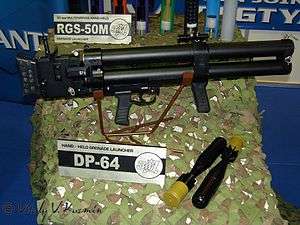DP-64
The DP-64 Nepryadva[1][2][3][4] is a Russian special-purpose double-barreled over/under grenade launcher designed to protect surfaced submarines, ships, dockyards, water development works, and other coastal installations from combat swimmers and naval special forces. The weapon is breech-loading and operates much like a large shotgun with a side-break breech, utilizing both direct and indirect iron sights. The weapon is capable of firing grenades indirectly at ranges up to 400 meters; however, these grenades act much like small depth charges, attacking submerged swimmers like true depth charges attack submersibles. A large polymer stock and the barrels themselves makes up the bulk of the weapon. The barrels are selected by turning a lever accommodated above the trigger guard. A front pistol grip is equipped for support and is out of alignment with the rear grip and trigger mechanism, providing a more natural grip while firing indirectly. The butt is fitted with a springy rubber pad to diminish felt recoil. Direct fire sights are also provided for use from a helicopter allowing for large areas to be patrolled and protected from enemy combat swimmers. The grenade launcher was developed in 1989 and introduced in 1990.
| DP-64 (ДП-64) | |
|---|---|
 The Russian DP-64 Anti-Saboteur weapon | |
| Type | Grenade launcher |
| Place of origin | Soviet Union |
| Service history | |
| In service | Russia |
| Used by | Russian Navy
|
| Production history | |
| Designer | Viktor Rebrikov |
| Designed | 1989 |
| Manufacturer | Degtyarev plant |
| Produced | 1990 |
| Specifications | |
| Mass | 10 kg (22 lbs) |
| Length | 820 mm (32 inches) |
| Width | 110 mm (4.3 inches) |
| Height | 275 mm (10.8 inches) |
| Caliber | 45 mm (1.771 inches) |
| Action | (side) break open |
| Maximum firing range | 400 meters (1,312 feet) |
| Feed system | 2 rounds |
| Sights | Direct & Indirect iron sights |
Detonation mechanism | Depth |
The DP-64 grenade launcher is now in serial production, said Pavel Sidorov, a representative of NPO Bazalt, the designer of the DP-64, at the 2015 International Defense Exhibition (IDEX) in Abu Dhabi. Sidorov said that the company received a large order from Russia's Defense Ministry for the weapons. Previously, the DP-64 has only been built in small numbers for the Russian coast guard, Federal Security Service, and a handful of marine units.
Though large and somewhat unwieldy, the DP-64 serves an important role with few modern contemporaries in the small arms world.
Ammunition
- Caliber: 45 mm
- Overall length: 303 mm
- Projectile length: 248 mm
- Cartridge length: 55 mm
- Shell weight: 0.65 kg
- Cartridge type: Rimmed, Separating base
- Operating temperature: +/- 50 °C
- Variants-
- FG-45 (ФГ-45) Fragmentation [14m blast radius, to 40m depth]
- SG-45 (СГ-45) Floating Flare (red) [for ~50 seconds]
- UG-45 (УГ-45) HE/Concussion
Users



See also
- DP-65
- MRG-1
- GM-94
- RGM-40 Kastet
- RGSh-30
- List of grenade launchers
- List of Russian weaponry